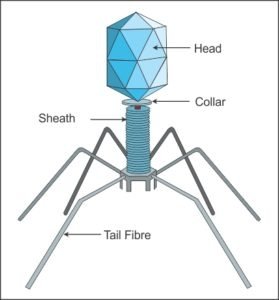CHAPTER THREE
3.0. VIRUSES
Viruses are chemical particles that are suspected to be pieces of genetic materials that have escaped from prokaryote and eukaryote cells and have the potential to replicate themselves only when they get back to a living cell environment. Viruses are generally diseased causing agent each viral particle virion.
3.1. Characteristics of viruses
- Viruses are chemical particles that can only be seen with an electron microscope
- Viruses consists of a small piece of nucleic acid which is either N.A or R.N.A surrounded by a protein code called capsid.
- Viruses are none living when not replicating but a life and active when replicating.
- Viruses can reproduce by invading living cells and therefore called obligate endo parasite meaning they can only live parasitically inside other cells.
- Viruses lack component necessarily for energy production and protein synthesis e.g. mitochondria, ribosomes etc.
- Viruses are specific to their host that is each type of virus will recognize an infect only certain types of cells
- Certain viruses e.g. the I.V contain an enzyme called reverse transcriptase which is used in nucleic acid synthesis.
DIAGRAM OF VIRUSES//////////////////////////////////////////////////////////////////////////////////


3.2. Replication or life cycle of a Bacteriophage i.e. D.N.A virus
Replication is generally the same in all phages and it called the lytic cycle. This is a type of viral replication cycle resulting in the release of new viruses by lysis (braking open) of the host cell. If the phage becomes dormant as in the lambda phage. These dormant phases are called prophage. It is then activated to complete it life cycle causing dead to the host cell.
Question: what activates this prophage in the lambda.
Such phase is described as lysogenic phases. The life cycle of a bacteriophage e.g. the T2 bacteriophage whose host is Escherichia coli. Proceeds as follows
Diagram; STRUCTURE OF H.I.V///////////////////////////////////////////////////////////////////

3.3. STRUCTURE OF A RETROVIRUS- H.I.V
The diseases AIDS is caused by a special type of R.N.A virus called H.I.V
AIDS stands for Acquire Immune Deficiency Syndrome while HIV stands for Human Immune deficiency virus. This term describes the main effect of the virus on the body. H.I.V belongs to a group of R.N.A VIRUSS CALLED RETRO VIRUSES because these viruses can convert their R.N.A back to a D.N.A copy using an enzyme called REVERSE TRANSCRIPTASE. Normally DNA makes RNA in a process called TRANSCRIPTASE. Making DNA from RNA is called Reverse transcriptase
HIV infects and destroys some white blood cells called T helper lymphocytes. Thereby crippling the immune system. The structure of HIV virus is shown below.
Diagram; REPLICATION OF RETRO VIRUS////////////////////////////////////////////////////////////////

3.4. Replication of retrovirus
The reproduction process of viruses is known as replication and involves making an exact copy of the viral nucleic acid. The AIDS virus contains a DOUBLE STANDARD RNA. It has an envelope protein synthesized as a glycoprotein. (a glycoprotein is a micro molecule consisting of one or more polypeptide links to one or more chains of sugar) The glycoprotein has affinity for the T-CELL, PLASMA MEMBRANE MOLECULE. Known as CD4 CELLS.
HIV main target are lymphocyte known as T4 helper cells. Infection leads to binding of the glycoprotein to the T4 helper cell. This is followed by the uptake of the viral particles into the cells of the host. This largely destroys the T cells and block their ability to recognize foreign material before dividing into the T cells. Micro phages monocytes as well as cell of the brain and spinal cord also carries the CD4 molecules of the glycoprotein. The replication of the H.I.V process through the following stages.
Stage 1:
Attachment: the virus approaches a T4 lymphocyte cells and attaches itself to a CD4 cell
STAGE 2:
FUSION: The viral glycoprotein attaches to a specific receptor protein in the cell surface membrane creating or poking an opening for entry. The virus enters the cell by endocytosis.
STAGE 3
UNCOATING: The virus removes its capsid and the viral R.N.A is releases into the cytoplasm of the host cell together with the enzyme reverse transcriptase or R.N.A dependent. DNA polymerase.
STAFE 4
REVERSE TRANSCRIPTION: The viral single stranded R.N.A is used as a template. Using reverse transcriptase, the R.N.A is converted to a D.N.A copy which is then duplicated to become double stranded D.N.A.
STAGE 5
REPLICATION: The DNA copy enters the nucleus and insert itself into the host DNA. Whenever the host cell divides it also makes a copy of the viral DNA increases the number of the infected cells. This viral copy is called Proviruses. The proviruses then go into an inactive stage known as the latency period which last for an average of 5years.
STAGE 6:
INTERGRATION: After the latency period, the virus become active again. The stimulus for converting a latent virus into an active virus is believed to be a foreign antigen in the CD4 cell
STAGE 7
BIOSYNTHESIS: New viral RNA is produced by the process of transcription using the viral DNA. Viral proteins are also produced using the host protein synthesis meetinery.
STAGE 8
MATURATION: THE NEW VIRAL RNA and viral protein assemble themselves to form new viruses
STAGE 9
RELEASE: the new viruses bud off from the cell surface membrane of the host cell by exocytosis and are eventually liberated into the blood stream where they infect new CD4 CELLS The cell eventually dies as a result of the infection
NOTE: This new virus may have the external structure slightly different from the original virus thus making identification by the already synthesized antibody difficult.
3.5. ECONOMIC IMPORTANCE OF VIRUS.
- Used for vaccines e.g. polio virus
- Used for genetic studies e.g. HIV
- Used for biological research e.g. T2 virus
- Used to destroy bacteria e.g. T2 virus (phages)
- Infect on plants e.g. tobacco virus.










Abu baruta
April 17, 2023
What an interesting class